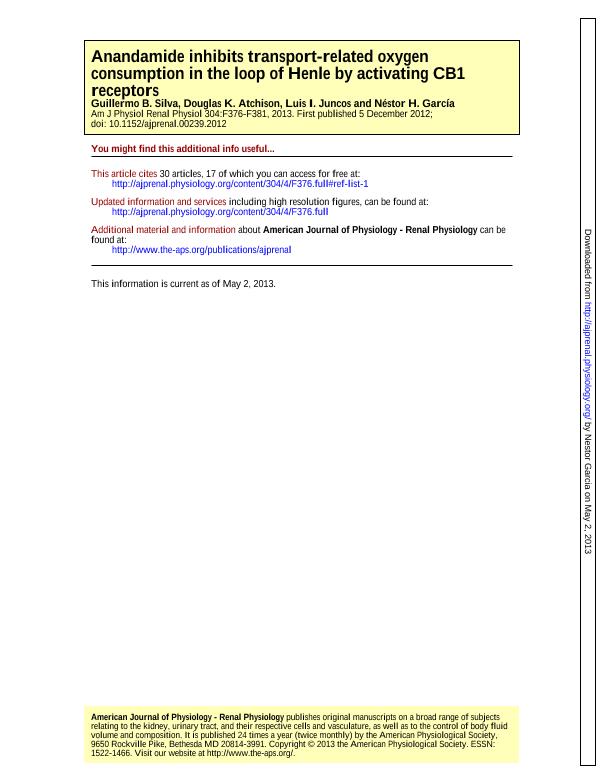Mostrar el registro sencillo del ítem
dc.contributor.author
Silva, Guillermo Benjamin

dc.contributor.author
Atchison, Douglas K.
dc.contributor.author
Juncos, Luis Isaias

dc.contributor.author
Garcia, Nestor Horacio

dc.date.available
2017-08-18T22:48:04Z
dc.date.issued
2013-02
dc.identifier.citation
Silva, Guillermo Benjamin; Atchison, Douglas K.; Juncos, Luis Isaias; Garcia, Nestor Horacio; Anandamide inhibits transport-related oxygen consumption in the loop of Henle by activating CB1 receptors; American Physiological Society; American Journal Of Physiology-renal Physiology; 304; 4; 2-2013; 376-381
dc.identifier.issn
1931-857X
dc.identifier.uri
http://hdl.handle.net/11336/22747
dc.description.abstract
The energy required for active Na chloride reabsorption in the thick ascending limb (TAL) depends on oxygen consumption and oxidative phosphorylation (OXP). In other cells, Na transport is inhibited by the endogenous cannabinoid anandamide through the activation of the cannabinoid receptors (CB) type 1 and 2. However, it is unclear whether anandamide alters TAL transport and the mechanisms that could be involved. We hypothesized that anandamide inhibits TAL transport via activation of CB1 receptors and NO. For this, we measured oxygen consumption (QO2) in TAL suspensions to monitor the anandamide effects on transport and OXP. Anandamide reduced QO2 in a concentration-dependent manner. During Na-K-2Cl cotransport and Na/H exchange inhibition, anandamide did not inhibit TAL QO2. To test the role of the cannabinoid receptors, we used specific agonists and antagonists of CB1 and CB2 receptors. The CB1-selective agonist WIN55212–2 reduced QO2 in a concentration-dependent manner. Also, the CB1 receptor antagonist rimonabant blocked the effect of anandamide on QO2. In contrast, the CB2-selective agonist JHW-133 had no effect on QO2, while the CB2 receptor antagonist AM-630 failed to block the anandamide effects on QO2. To confirm these results, we measured CB1 and CB2 receptor expression and only CB1 expression was detected. Because CB1 receptors are strong nitric oxide synthase (NOS) stimulators and NO inhibits transport in TALs, we evaluated the role of NO. Anandamide stimulated NO production and the NOS inhibitor NG-nitro-l-arginine methyl ester blocked the anandamide effects on QO2. We conclude that anandamide inhibits TAL Na transport-related QO2 via activation of CB1 receptor and NOS.
dc.format
application/pdf
dc.language.iso
eng
dc.publisher
American Physiological Society

dc.rights
info:eu-repo/semantics/openAccess
dc.rights.uri
https://creativecommons.org/licenses/by-nc-sa/2.5/ar/
dc.subject
Nkcc2
dc.subject
Diuretics
dc.subject
Tubular Transport
dc.subject
Molecular Phisiology
dc.subject.classification
Bioquímica y Biología Molecular

dc.subject.classification
Medicina Básica

dc.subject.classification
CIENCIAS MÉDICAS Y DE LA SALUD

dc.title
Anandamide inhibits transport-related oxygen consumption in the loop of Henle by activating CB1 receptors
dc.type
info:eu-repo/semantics/article
dc.type
info:ar-repo/semantics/artículo
dc.type
info:eu-repo/semantics/publishedVersion
dc.date.updated
2017-08-18T21:35:00Z
dc.identifier.eissn
1522-1466
dc.journal.volume
304
dc.journal.number
4
dc.journal.pagination
376-381
dc.journal.pais
Estados Unidos

dc.description.fil
Fil: Silva, Guillermo Benjamin. Universidad Católica de Córdoba; Argentina. Fundación Robert Cade; Argentina. Consejo Nacional de Investigaciones Científicas y Técnicas; Argentina
dc.description.fil
Fil: Atchison, Douglas K.. Wayne State University; Estados Unidos. Henry Ford Hospital; Estados Unidos
dc.description.fil
Fil: Juncos, Luis Isaias. Fundación Robert Cade; Argentina
dc.description.fil
Fil: Garcia, Nestor Horacio. Consejo Nacional de Investigaciones Científicas y Técnicas. Centro Científico Tecnológico Conicet - Córdoba. Instituto de Investigaciones en Ciencias de la Salud. Universidad Nacional de Córdoba. Instituto de Investigaciones en Ciencias de la Salud; Argentina
dc.journal.title
American Journal Of Physiology-renal Physiology

dc.relation.alternativeid
info:eu-repo/semantics/altIdentifier/doi/http://dx.doi.org/10.1152/ajprenal.00239.2012
dc.relation.alternativeid
info:eu-repo/semantics/altIdentifier/url/http://ajprenal.physiology.org/content/304/4/F376
Archivos asociados
